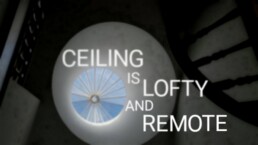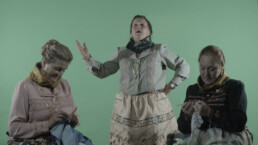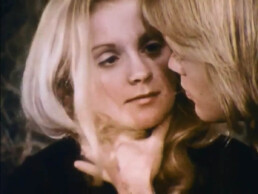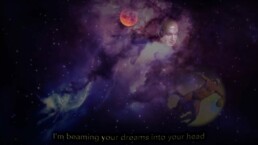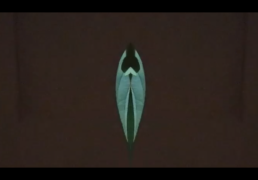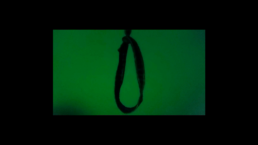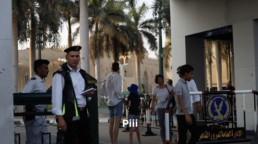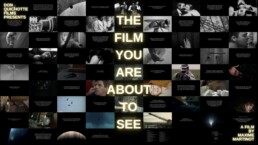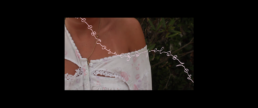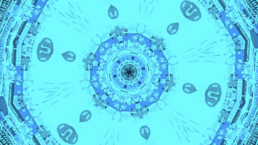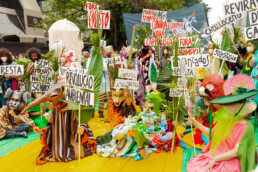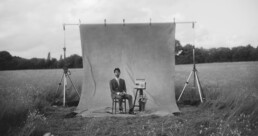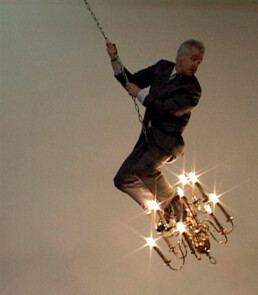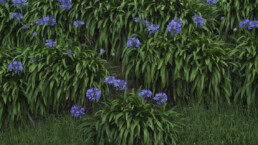FUSO 2023 – 22 a 27 de Agosto
23 Agosto, 22h00 MAAT
Museu de Arte, Arquitetura e Tecnologia
Curador
Jean-François Chougnet
Para a sua décima quinta edição o Festival Fuso apresenta um novo caleidoscópio de imagens utópicas, distópicas, políticas e sobretudo poéticas. O que caracteriza as propostas feitas no âmbito do Open Call (regras do jogo: obras de uma duração inferior a 10 minutos e realizadas entre 2021 e 2023) é um olhar dinâmico sobre um mundo pós-pandemia. Mais do que nos anos anteriores, sente-se agora um questionamento mais pessoal, singular.
O número de candidaturas continua a crescer (mais de 250 em 2023). Da difícil escolha entre tantas propostas, as doze selecionadas demonstram a diversidade do panorama artístico português. Para esta nova edição, os projetos traduzem em imagens, letras, palavras, sons e corpos as questões que atravessam as nossas sociedades.
Escutemos e demoremo-nos nas vibrações destas promessas, destas plantas frágeis que florescem no seio das ruínas. Acolhamos esta pluralidade, por vezes desconcertante, de olhares que se abrem à multiplicação de possibilidades e à construção de novos imaginários.
João Saramago – BETRAYAL
A curta ilustra as tentativas do ser humano em tentar alcançar redenção num mundo ameaçado pela catástrofe natural. Pelo olhar do artista, a humanidade está já condenada devido às consequências das nossas ações e, apesar do medo e incerteza constante, o protagonista embarca numa viagem onde tenta reparar e curar obsessivamente a paisagem à sua volta. Será que ele está ciente? Será possível remendar os nossos erros?
Sarah Legow – DEAR CEILING
Uma carta de amor do chão para o tecto escrita em stop-motion, o vídeo “Dear Ceiling” tem como ponto de partida a rejeição de uma visão do mundo centrada no ser humano. Na esperança de despertar a relação do espectador com o seu ambiente construído, o trabalho é um convite lúdico para reimaginar a arquitectura que nos rodeia como sendo tão espiritualmente desejosa e libidinosa como nós.
Ian Capillé – ENSAIO PARA SONHO
“Fiz um convite para Girassol fugir comigo.”
O que acontece com o público quando diante de um ecrã continuamente negro? Será que isso tem a ver com a morte? Ou será que é como um despertar? Busquei quase que uma religião da imagem fotográfica, aprofundando amorosamente na sua misteriosa escuridão luminosa.
Beatriz Soares Dias e Francisca Manuel – ESCÓRIA
As Minas de São Domingos em Mértola, considerado um dos mais importantes e estruturantes investimentos industriais realizados em Portugal até ao início do séc. XX, é o cenário de uma colaboração entre duas áreas, dança e cinema. Escória parte da cronologia de acontecimentos que foram transformando as Minas, um lugar de fantasmagoria e cristalização, com ruínas e memórias. A importância da relação de um corpo numa paisagem-ruína como metáfora para os corpos mineiros que sobre exploração trabalharam exaustivamente neste lugar.
Ricardo Leandro – EXCERTO DE UMA CEGADA
As “cegadas” são pequenas peças de teatro escritas e representadas por membros da comunidade de Nazaré (PT), e apresentadas nos bailes de Carnaval. Nos meses que antecedem o Carnaval, é normal que estes grupos se reúnam em espaços como garagens para discutir e ensaiar os textos – muitas vezes centrados na crítica social local ou em vivências do passado – e as músicas que são interpretadas entre as cenas, geralmente cantadas a cappella ou acompanhadas por uma única guitarra. Um destes grupos foi desafiado a entrar num estúdio de televisão para transformar um excerto de uma peça sua num produto comercial e, à medida que o estúdio é revelado, é também apresentada ao público uma nova abordagem à estética tradicional destas performances.
Francisca Dores – HOW TO BE A CANDID WOMAN
Crítica à representação e educação das mulheres, ao longo dos anos, através do cinema e dos meios de comunicação social.
António Olaio – I’M BEAMING MY DREAMS INTO YOUR HEAD
Uma performance que quer o lugar do palco e que, centrífuga ou centrípeta, em expansão ou implosão, leva o artista à performatividade da pintura que parece pintura, às canções que parecem canções, à performance que se pode parecer com qualquer outra coisa… Na canção “I’m beaming my dreams into your head” a cabeça do artista canta para si próprio em performance realizada quatro décadas atrás. Uma vontade de sublinhar a importância do lugar onde todo é síncrono como os diferentes momentos do percurso de um artista na sua cabeça.
Lula Pena – LA FEMME TRANQUILLE DE LA TRIBU
um poema sonoro e visual interespécies.
Miguel Leonardo – O RAPAZ QUE PENSAVA DEMAIS
Um rapaz do mundo moderno, incapaz de sobreviver dentro da sua própria cabeça-pensante. Critica a sociedade atual e vive no mesmo paradigma, fechado e isolado no seu quarto. Feito um desistente no nosso Planeta Terra durante a pandemia.
Maria Peixoto Martins – PI PI PI PI PI
Uma cidade de 20 milhões de habitantes. Todos têm que se deslocar, e usam o carro como principal meio de transporte. Para além da quantidade de pessoas a conduzir, têm também um código da estrada muito peculiar criado pelos condutores, que usam as buzinas e os olhares entre os retrovisores para comunicarem uns com os outros. Não existe silêncio, os motoristas buzinam dia e noite. Neste vídeo conseguimos ouvir cerca de 581 buzinas, transportando-nos para outra realidade. Com foco na experiência sensorial, a visão e a audição despertam. O ruído é a palavra chave desta obra.
Rafael Raposo Pires – RUÍDOS DA ESPERA
Ruídos da espera é uma peça audiovisual produzida junto à entrada Sul do Túnel de Tende, na fronteira entre França e Itália. No vídeo, pedras são atiradas contra um aglomerado de rails de proteção da estrada. Devido a uma tempestade que atingiu a região, os deslizamentos de terra que se seguiram varreram casas, estradas e outras infraestruturas. Um ano depois da catástrofe, amontoados de rails de proteção ainda estão espalhados ao longo da única via de acesso. Muitos moradores aguardam ainda a reconstrução das suas casas.
Maxime Martinot – THE FILM YOU ARE ABOUT TO SEE
Um filme que coleciona as imagens que fazem avisos ou contextualizações dos filmes a priori: desde a indicação de que se trata de uma história real a avisos antipirataria. As ligações entre lei e liberdade de criação poderão ser apenas acidentais. Acautelamos que este filme pode conter avisos.
Montagem: Maxime Martinot
Grafismo: Catarina Boieiro
Correção de cor: Thibault Solinhac
Sofia Santa-Rita – VOZES PICTÓRICAS
Uma reflexão sobre a poesia concreta em que a letra é a protagonista, este filme experimental explora as fronteiras entre a poesia e o cinema. A letra pressupõe e provoca sempre uma ligação proveniente da sua familiaridade. Mesmo que não seja imediatamente “legível” é reconhecível. Assim, estes versos, dispostos em três capítulos (desenquadrado, desenleado, desvelado) seguem camisas de noite que acompanham a mesma família há várias gerações. A palavra texto, derivada do latim ‘textum’ que significa tecido, contém na sua génese uma pista para esta história, que é tecida, servindo-se do traje de noite como catalisador para uma contemplação em torno da intimidade e da memória.
FUSO 2023 – August 22nd to 27th
August 23th, 10pm MAAT
MAAT – Museum of Art, Architecture and Technology
Curator
Jean-François Chougnet
For its fifteenth edition, Festival Fuso presents a new kaleidoscope of utopian, dystopian, political and above all poetic images. What characterizes the proposals made under the Open Call (rules of the game: works of less than 10 minutes created between 2021 and 2023) is a dynamic look at a post-pandemic world. More than in previous years, there is now a more personal, singular questioning.
The number of applications continues to grow (more than 250 in 2023): from the difficult choice among so many proposals, the twelve selected demonstrate the diversity of the Portuguese artistic panorama. For this new edition, the projects translate into images, letters, words, sounds and bodies the issues that cut across our societies.
Let us listen and dwell on the vibrations of these promises, these fragile plants that flourish in between the ruins. Let us welcome this sometimes-disconcerting plurality of looks that are open to the multiplication of possibilities and the construction of new imaginaries.
João Saramago – BETRAYAL
This short illustrates the attempts of us humans for redemption in a damaged world threatened by environmental shifts. Through the eyes of the artist, we all are already doomed by the consequences of our actions, and, despite constant fear and uncertainty, he extrapolates to the outside world, obsessed with repairing and fixing the landscape around him. Is he delusional? Will he be able to amend our mistakes?
Sarah Legow – DEAR CEILING
A love letter from the floor to the ceiling spelled out in stop-motion text, the video “Dear Ceiling” takes as its starting point the rejection of a human-centered vision of the world. Hoping to awaken the viewer’s relationship to their built environment, the work is a playful invitation to reimagine the architecture around us as just as spiritually yearning and libidinous as we are.
Ian Capillé – ENSAIO PARA SONHO
“I made an invitation for Girassol to run away with me.”
What happens to the audience when faced with a continuously black screen? Does it have anything to do with death? Or is it like an awakening? I sought almost a religion of the photographic image, delving lovingly into its mysterious luminous darkness.
Beatriz Soares Dias e Francisca Manuel – ESCÓRIA
The Mines of São Domingos in Mértola, considered one of the most important and structuring industrial investments made in Portugal until the beginning of the 20th century, is the setting for a collaboration between two areas, dance and cinema. Escória starts from the chronology of events that transformed the Mines, a place of phantasmagoria and crystallization, with ruins and memories. The relevance of the relationship of a body in a ruin-landscape as a metaphor for the mining bodies that over exploitation worked exhaustively in this place.
Ricardo Leandro – EXCERTO DE UMA CEGADA
The “cegadas” are short plays written and performed by members of the community from Nazaré (PT) and are presented during the carnival balls. In the months leading up to Carnival, it is normal for these groups to get together in spaces like parking garages to discuss and rehearse the scripts – often focused on local social critique or stories from the past – and the songs that are performed between the scenes, which are usually sung a cappella or accompanied by a single guitar. One of these groups was challenged to enter a TV studio in order to convert an excerpt from their play into a commercial product, and as the studio is revealed, a new approach to the traditional aesthetics of these performances is also introduced to the public.
Francisca Dores – HOW TO BE A CANDID WOMAN
Critique of the representation and education of women over the years through film and media.
António Olaio – I’M BEAMING MY DREAMS INTO YOUR HEAD
A performance that claims the place of the stage and that, centrifugal or centripetal, expanding or imploding, led the artist to the performativity of painting that looks like painting, to songs that sound like songs, to performance that can look like anything else… In the song “I’m beaming my dreams into your head” the artist’s head sings to himself in a performance that happened four decades ago. The intentional desire to underline the importance of the place of all the different moments of an artist’s journey in his head.
Lula Pena – LA FEMME TRANQUILLE DE LA TRIBU
an interspecies sound and visual poem.
Miguel Leonardo – O RAPAZ QUE PENSAVA DEMAIS
A boy from the modern world lives without being able to survive inside his head overthinking. Criticize the current society, the one who lives in the same closed and isolated paradigm in his home. He became a quitter on our Planet Earth during the pandemic.
Maria Peixoto Martins – PI PI PI PI PI
A city with 20 million inhabitants.
Everyone has to commute and use cars as their main means of transportation. In addition to the large number of people driving, they also have a very peculiar traffic code. Rules created by the drivers themselves. They use honks and glances in the rearview mirrors to communicate with each other. There is no silence, drivers honk day and night. In this video we can hear around 581 honks, transporting us to another reality. Focusing on the sensory experience, sight and hearing are awakened. Noise is one of the keywords for the work.
Rafael Raposo Pires – RUÍDOS DA ESPERA
Ruídos da espera is an audiovisual piece produced near the South entrance of Tunnel de Tende, in the border between France and Italy. In the video stones are being thrown towards road rails. Due to a storm that hit the region, landslides swept homes, roads and other infrastructures. More than one year after the catastrophe, piles of road rails are still scattered along the only access road. Many inhabitants are still waiting for their homes to be rebuilt.
Maxime Martinot – THE FILM YOU ARE ABOUT TO SEE
Please note that the film you are about to see is taken from real material of film history, namely the disclaimers and warnings that frame the existence of many films. However, any collusion between art and industry, any conflict of interest between freedom of creation and the law, or any hint of moralism on the life of images, would be purely incidental and unintentional.
Editing: Maxime Martinot
Graphics: Catarina Boieiro
Color correction: Thibault Solinhac
Sofia Santa-Rita – VOZES PICTÓRICAS
A reflection on concrete poetry in which the letter is the protagonist, this experimental film explores the boundaries between poetry and cinema. “The letter” always provokes a connection arising from its familiarity. Even if not immediately “readable” it is recognizable. Thus, these verses, displayed in three chapters (displaced, disentangled and unveiled) follows nightdresses that have been in the same family for several generations. The word text, derived from Latin ‘textum’ that means fabric, contains in its genesis a clue to this story, which is woven, using the evening costume as a catalyst for contemplation around intimacy and memory.

